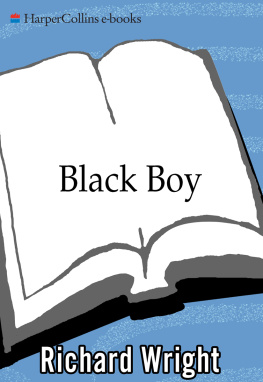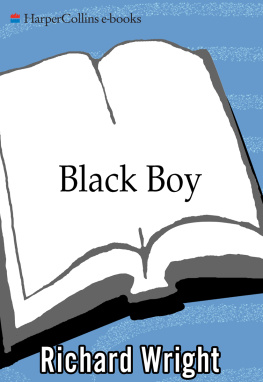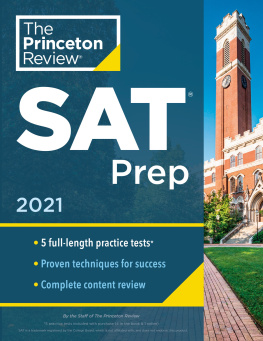With a Foreword by Edward P. Jones
The Signet paperback copies of BLACK BOY that the teacher , Charlotte Crawford, distributed to her tenth graders in September 1965 had white covers with a large, rather abstract black fist dead in the center of those covers. Fist as in black power, I suppose, though none of her students had ever uttered those words. We were fifteen and sixteen years old, and we were new to high school, as Miss Crawford was new to teaching. The Negro students in that D.C. classroom had none of the consciousness that children of the same color and ages in the civil rights turmoil of Mississippi or Alabama or Georgia or South Carolina might have had. The riots in Washington, D.C., after the murder of Martin Luther King, Jr., were still a long time in the future. We knew worldly things, but it was not yet a very big world. At the top of the books cover, there were some rather complimentary words from a reviewer, but those words meant nothing to me. The book was only important because my teacher, one of the few arbiters in my life of what was good and what was not good, had given it to me. Below the reviewers words was Richard Wrights name, which I had discovered two months before, and then the big words BLACK BOY under his name. Wright was nearly six years dead when Miss Crawforda thin, short woman with eyeglasses and a warm naturegave us the books, but his death and his life and his work meant nothing to me that afternoon. All of that and more were years and years away. The book was brand-new and it smelled new. Miss Crawfords class had some twenty Negro children, and of the problems we had, poverty was perhaps foremost for most of us. A condition we did not have a name for yet. Some of Miss Crawfords students wanted to know if we could keep the booksfor we could count all day and night the things that were tenuous in our lives. The teacher said they were ours to keep, and I have mine to this day. The cover is creased, the pages are dog-eared for I acquired the book before I knew how precious pages were. There are no underlined sentences. There are no notes in the margins. I had not learned that one could and should do those things; but even if I had known to do them, I would have been too amazed, too absorbed to stop. The only record I have of what I experienced as I read is the book itself and what is left of my memory. That edition of BLACK BOY with its red border was to be only the fourth book I ever read in my life.
I had not been a stranger to wordsonly to words that were unaccompanied by pictures. Before books without pictures of some sort, there were funny bookswhat the rest of the universe calls comic booksand books of fairy or folk tales, all of them illustrated with at least one picture.
In 1964, my sister and I stayed the entire summer with relatives in South Boston, Virginia. They passed the civil rights bill that summer and my cousins and their friends were excited about being able finally to use the white swimming pool, the only one in the area. It was no big holler for meI couldnt swim, for one thing, and in D.C., Negroes had a number of places to swim. I had brought some funny books down to South Boston, but by the first of July, I had read them all, as well as an old copy of Time that my aunt had lying around. Then, one afternoon, as I sat bored and lost on the porch of the tiny house my cousin and her husband lived in next door to my aunt and my other cousins, I picked up from a small table Who Killed Stella Pomeroy ? It was a British mystery and it was the first book of any kind that I ever read that came with no pictures. I do not remember any of it, not one character, not who poor Stella was, and not who wanted her dead. There is only the unfailing memory of being thrust into a different world and seeing and knowing that world and its people simply with the words the author gave me. He said in his novel, word after word, that the place and the people were real and I believed him.
The next summer, 1965, my sister and I stayed with another aunt in Brooklyn, New York. From time to time, when my aunt went to clean someones house, we were left alone and I took to snooping. One day in a cabinet I came upon Native Son and His Eye Is on the Sparrow , the autobiography of the black actress Ethel Waters. They were the second and third books without pictures that I ever read. And the first books about black people. As I read on, Brooklyns Franklin Avenue, the worldin a thousand ways I could not have describedgot smaller, if only because Wrights Chicago and Waterss midwest told me about territory beyond my own D.C., but territory that was nevertheless populated with people I had known, in one way or another, all my life. Even Bigger Thomas, though I had known him on a much smaller scale and in a far less violent and pathological way.
After Who Killed Stella Pomeroy? in 1964 in Virginia, I had returned to Washington and to funny books. But after that summer in Brooklyn in 1965, Miss Crawford gave me BLACK BOY in September, and before very longcertainly, if memory is doing right by me, way before Christmasfunny books were an almost nonexistent part of my life. Not long after I came back from Brooklyn, we had moved once again, for about the fifteenth or sixteenth time since I had come into the world. About once for every year of my life. I no longer had the sturdiness or the heart of a boy of eight or nine or ten who made friends easily in a new neighborhood, so I now had friends beyond those I saw during the school day. And I had been pubertized, though my first date was nearly four years away.
It is only in rereading BLACK BOYand in reading for the first time the Chicago section of the book that was not in my Signet editionthat I see much of what held me some thirty years earlier. Wright was living a southern life I knew in the city: one of constant moving from one slum house to anotherthe heart wears out in having to pick itself up and make a new home so often. A treacherous landscape of crops and bad times and moonlit nights that I knew about from stories told by southern-born adults who had escaped to D.C.; a place where white people with unkind hearts were as plentiful as fertile soil. A father out there somewhere who could have helped but who chose not to. (Wright was perhaps more forgiving. But for what my father did not do, I decided not to buy him a tombstone when he died. His grave may still be unmarked, though I have not seen it since the first time in 1975.) And in BLACK BOY, all the way through, I was again witness to the fear, day after day, that his motherthe one person who stood between him and a world that seemed to enjoy making widows and orphanswould be swept out of his life. Very little of this was in Native Son , and it helps explain why reading BLACK BOY again was like reading ones journal that had not been opened for ages. I know this person, you sometimes say aloud; I know what he went through; and I know how far he has come.
At the back of my 1965 copy of BLACK BOY there were a few pages describing other books that Signet published and one by one I began ordering them, and the books I ordered had other back pages describing other books. Those I did not get by mail, I bought in Trovers Bookstore on Eleventh Street. An autobiography of an impoverished black woman and her children living in a Brazilian favella, Go Tell It on the Mountain; Invisible Man . I do not know what happened to the funny books I owned in the last months of 1965. I dont believe any of them survived the first months of 1966. I suppose some of them might be worth something today, depending upon their condition. My copy of BLACK BOY has value only to me.








